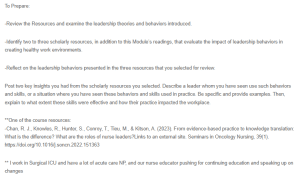Discussion – Leadership Theories in Practice
Key Insights
In reflecting on leadership behaviors and their impact on creating healthy work environments, two key insights emerged from the selected scholarly resources. First, leadership transformation is crucial in helping to bridge this gap in knowledge translation within the healthcare systems. According to Chan et al. (2023), transformational leaders embrace appropriate evidence-based changes and encourage team members to learn from their experiences and continuously improve, which is requisite in the dynamic healthcare context. These leaders demonstrate appropriate behavioral expectations and challenge staff to make new connections so that they come up with new ideas and work in a team. This leadership approach assists in promoting the implementation of research among health practitioners and enhancing patient care and staff satisfaction (Chan et al., 2023).
Second, Jackson et al. (2023) also emphasize the importance of leadership in cultivating healthy workplace conditions, particularly via supervisory support and communication. Managers who create such cultures assist in reducing stress and possible burnout among employees, especially in the ICU. Leadership also encompasses emotional intelligence, which is known to have positive impacts on nurses’ working satisfaction and absence rates. This leadership approach fosters safety and teamwork, fundamentals to effective patient care delivery, and the creation of a stable and productive staff (Jackson et al., 2023).
Leadership Behaviors Observed in Practice
In my experience working in the surgical ICU, I have observed these leadership behaviors firsthand. Our nurse educator embodies the principles of transformational leadership by being a self-learner and encouraging followers to suggest change. For instance, during a recent shift, she conducted a brain talk meeting on integrating fresh process changes for post-operation care. While educating everyone on best practices, she also encouraged active participation from her team to contribute ideas, which fostered involvement. Notably, this approach has proved effective because it has enhanced teamwork and ensured that implementing new care protocols becomes easier to handle.
Effectiveness and Impact on the Workplace
The effects of these leadership behaviors on the workplace have been felt. Promoting transformational leadership, emotional intelligence, organizational culture, staff morale, interdisciplinary collaboration, and patient care are some of the benefits gained due to increased transformational and emotionally intelligent leadership practices. This work environment has played an important role in developing and promoting a healthy clinical environment that supports staff and patient care (Iqbal et al., 2020).
Conclusion
Transformational and emotionally intelligent leadership behaviors are most effective in the healthcare context. These types of leadership not only foster a positive organizational culture and collaborative work but also guarantee that applied interventions adhere to evidence-based practices. Evidence for outcomes in both employees and patients also supports the application of these leadership theories.
References
Chan, R. J., Knowles, R., Hunter, S., Conroy, T., Tieu, M., & Kitson, A. (2023). From evidence-based practice to knowledge translation: What is the difference? What are the roles of nurse leaders? Seminars in Oncology Nursing, 39(1), 1–6. https://doi.org/10.1016/j.soncn.2022.151363
Iqbal, K., Fatima, T., & Naveed, M. (2020). The impact of transformational leadership on nurses’ organizational commitment: A multiple mediation model. European Journal of Investigation in Health, Psychology and Education, 10(1), 262–275. https://doi.org/10.3390/ejihpe10010021
Jackson, H. R., Miglietta, L., Habgood-Coote, D., D’Souza, G., Shah, P., Nichols, S., Vito, O., Powell, O., Davidson, M. S., Shimizu, C., Agyeman, P. K. A., Beudeker, C. R., Brengel-Pesce, K., Carrol, E. D., Carter, M. J., De, T., Eleftheriou, I., Emonts, M., Epalza, C., . . . Levin, M. (2023). Diagnosis of multisystem inflammatory syndrome in children by a whole-blood transcriptional signature. Journal of the Pediatric Infectious Diseases Society, 12(6), 322–331. https://doi.org/10.1093/jpids/piad035
ORDER A PLAGIARISM-FREE PAPER HERE
We’ll write everything from scratch
Question
To Prepare:
-Review the Resources and examine the leadership theories and behaviors introduced.

Discussion – Leadership Theories in Practice
-Identify two to three scholarly resources, in addition to this Module’s readings, that evaluate the impact of leadership behaviors in creating healthy work environments.
-Reflect on the leadership behaviors presented in the three resources that you selected for review.
Post two key insights you had from the scholarly resources you selected. Describe a leader whom you have seen use such behaviors and skills, or a situation where you have seen these behaviors and skills used in practice. Be specific and provide examples. Then, explain to what extent these skills were effective and how their practice impacted the workplace.
**One of the course resources:
-Chan, R. J., Knowles, R., Hunter, S., Conroy, T., Tieu, M., & Kitson, A. (2023). From evidence-based practice to knowledge translation: What is the difference? What are the roles of nurse leaders?Links to an external site. Seminars in Oncology Nursing, 39(1). https://doi.org/10.1016/j.soncn.2022.151363
** I work in Surgical ICU and have a lot of acute care NP, and our nurse educator pushing for continuing education and speaking up on changes

